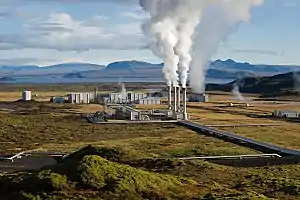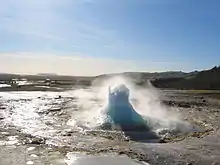Energy in Iceland
About 85% of the total primary energy supply in Iceland is derived from domestically produced renewable energy sources. This is the highest share of renewable energy in any national total energy budget.[1] Geothermal energy provided about 65% of primary energy in 2016, the share of hydropower was 20%, and the share of fossil fuels (mainly oil products for the transport sector) was 15%.[1]
In 2015, the total electricity consumption in Iceland was 18,798 GWh. Renewable energy provided almost 100% of production, with about 73% coming from hydropower and 27% from geothermal power.[1] Most of the hydropower plants are owned by Landsvirkjun (the National Power Company) which is the main supplier of electricity in Iceland.[2]
The main use of geothermal energy is for space heating, with the heat being distributed to buildings through extensive district-heating systems.[1] About 85% of all houses in Iceland are heated with geothermal energy.[2]
Iceland is the world's largest green energy producer per capita and largest electricity producer per capita, with approximately 55,000 kWh per person per year. In comparison, the EU average is less than 6,000 kWh.[1] Most of this electricity is used in energy-intensive industrial sectors, such as aluminium production, which developed in Iceland thanks to the low cost of electricity. According to the Index of Geopolitical Gains and Losses after Energy Transition (GeGaLo Index), Iceland is ranked no. 1 among 156 countries and will be the greatest winner after a full-scale transition to renewable energy is completed.[3]
Energy resources
Iceland's unique geology allows it to produce renewable energy relatively cheaply, from a variety of sources. Iceland is located on the Mid-Atlantic Ridge, which makes it one of the most tectonically active places in the world. There are over 200 volcanoes located in Iceland and over 600 hot springs.[4] There are over 20 high-temperature steam fields that are at least 150 °C [300 °F]; many of them reach temperatures of 250 °C.[4] This is what allows Iceland to harness geothermal energy, and these steam fields are used for heating everything from houses to swimming pools. Hydropower is harnessed through glacial rivers and waterfalls, both of which are in Iceland.[4]
Sources
.png.webp)
Hydropower
The first hydropower plant was built in 1904 by a local entrepreneur.[5] It was located in a small town outside of Reykjavík and produced 9 kW of power. The first municipal hydroelectric plant was built in 1921, and it could produce 1 MW of power. This plant single-handedly quadrupled the amount of electricity in the country.[6] The 1950s marked the next evolution in hydroelectric plants. Two plants were built on the Sog River, one in 1953 which produced 31 MW, and the other in 1959 which produced 26.4 MW. These two plants were the first built for industrial purposes and they were co-owned by the Icelandic government.[6] This process continued in 1965 when the national power company, Landsvirkjun, was founded. It was owned by both the Icelandic government and the municipality of Reykjavík. In 1969, they built a 210 MW plant on the Þjórsá River that would supply the southeastern area of Iceland with electricity and run an aluminum smelting plant that could produce 33,000 tons of aluminum a year.[6]
This trend continued and increases in the production of hydroelectric power are directly related to industrial development. In 2005, Landsvirkjun produced 7,143 GWh of electricity total of which 6,676 GWh or 93% was produced via hydroelectric power plants. 5,193 GWh or 72% was used for power-intensive industries like aluminum smelting.[7] In 2009 Iceland built its biggest hydroelectric project to date, the Kárahnjúkar Hydropower Plant, a 690 MW hydroelectric plant to provide energy for another aluminum smelter.[8] This project was opposed strongly by environmentalists.
Other hydroelectric power stations in Iceland include: Blöndustöð (150 MW), Búrfellsstöð (270 MW), Hrauneyjafosstöð (210 MW), Laxárstöðvar (28 MW), Sigöldustöð (150 MW), Sogsstöðvar (89 MW), Sultartangastöð (120 MW), and Vatnsfellsstöð (90 MW).[9]
Iceland is the first country in the world to create an economy generated through industries fueled by renewable energy, and there is still a large amount of untapped hydroelectric energy in Iceland. In 2002 it was estimated that Iceland only generated 17% of the total harnessable hydroelectric energy in the country. Iceland's government believes another 30 TWh of hydropower could be produced each year, while taking into account the sources that must remain untapped for environmental reasons.[8]
Geothermal power
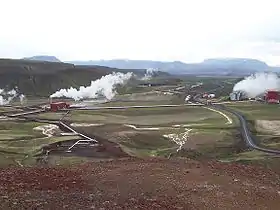
For centuries, the people of Iceland have used their hot springs for bathing and washing clothes. The first use of geothermal energy for heating did not come until 1907 when a farmer ran a concrete pipe from a hot spring to lead steam into his house.[5] In 1930, the first pipeline was constructed in Reykjavík and was used to heat two schools, 60 homes, and the main hospital. It was a 3 km (1.9 mi) pipeline that ran from one of the hot springs outside the city. In 1943 the first district heating company was started with the use of geothermal power. An 18 km (11 mi) pipeline ran through the city of Reykjavík, and by 1945 it was connected to over 2,850 homes.[4]
Currently geothermal power heats 89%[4] of the houses in Iceland, and over 54% of the primary energy used in Iceland comes from geothermal sources. Geothermal power is used for many things in Iceland. 57.4% of the energy is used for space heat, 25% is used for electricity, and the remaining amount is used in many miscellaneous areas such as swimming pools, fish farms, and greenhouses.[4]
The government of Iceland has played a major role in the advancement of geothermal energy. In the 1940s the State Electricity Authority was started by the government in order to increase the knowledge of geothermal resources and the utilization of geothermal power in Iceland. The agency's name was later changed to the National Energy Authority (Orkustofnun) in 1967. This agency has been very successful and has made it economically viable to use geothermal energy as a source for heating in many different areas throughout the country. Geothermal power has been so successful that the government no longer has to lead the research in this field because it has been taken over by the geothermal industries.[4]
Geothermal power plants in Iceland include Nesjavellir (120 MW), Reykjanes (100 MW), Hellisheiði (303 MW), Krafla (60 MW), and Svartsengi (46.5 MW).[9] The Svartsengi power plant and the Nesjavellir power plant produce both electricity and hot water for heating purposes. The move from oil-based heating to geothermal heating saved Iceland an estimated total of US $8.2 billion from 1970 to 2000 and lowered the release of carbon dioxide emissions by 37%.[4] It would have taken 646,000 tons of oil to heat Iceland's homes in 2003.
The Icelandic government also believes that there are many more untapped geothermal sources throughout the country, estimating that over 20 TWh per year of unharnessed geothermal energy is available. This is about 3.3% of the 600TWh per year of electricity used in Germany. Combined with the unharnessed feasible hydropower, tapping these sources to their full extent would provide Iceland another 50 TWh of energy per year, all from renewable sources.[8]
Iceland's abundant geothermal energy has also enabled renewable energy initiatives, such as Carbon Recycling International's carbon dioxide to methanol fuel process, which could help reduce Iceland's dependence on fossil fuels.[10]
Solar power
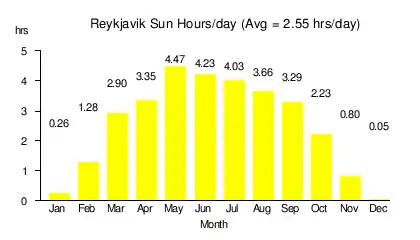 Source: NREL[11] |
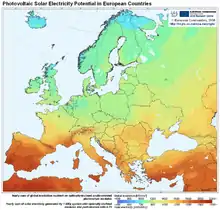 Solar insolation |
Iceland has relatively low insolation, due to the high latitude, thus limited solar power potential. The total yearly insolation is about 20% less than Paris, and half as much as Madrid, with very little in the winter.
Wind power
There is an ongoing project in checking the feasibility of a wind farm in Iceland. In 2012, two wind turbines were installed in South Iceland and in 2015 a wind atlas, named icewind, was completed.[12]
Experiments with hydrogen as a fuel
Imported oil fulfills most of Iceland's remaining energy needs, the cost of which has caused the country to focus on domestic renewable energy. Professor Bragi Árnason first proposed the idea of using hydrogen as a fuel source in Iceland during the 1970s when the oil crisis occurred. The idea was considered untenable, but in 1999 Icelandic New Energy was established to govern the transition of Iceland to the first hydrogen society by 2050.[13]
In the early 2000s, the viability of hydrogen as a fuel source was considered, and whether Iceland's small population, small scale of the country's infrastructure, and access to natural energy would ease a transition from oil to hydrogen.
ECTOS demonstration project
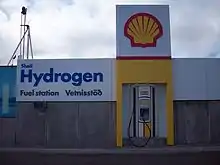
The ECTOS (Ecological City Transport System) demonstration project ran from 2001 to August 2005.[14] The project used three hydrogen fuel cell buses and one fuel station.[15]
The country's first hydrogen station opened in 2003 in Reykjavík.[16] To avoid transportation difficulties, hydrogen is produced on-site with electrolysis (breaking down water into hydrogen and oxygen).[13]
Hydrogen project
From January 2006 to January 2007 testing of hydrogen buses continued as part of the HyFLEET:CUTE project, which spanned 10 cities in Europe, China and Australia and was sponsored by the European Commission's 6th framework programme.[17] The project studied the long-term effects and most-efficient ways of using hydrogen powered buses. The buses were run for longer periods of time and the durability of the fuel cell was compared to the internal combustion engine, which can theoretically last much longer. The project also compared the fuel efficiency of the original buses with that of new buses from a number of manufacturers.[13]
Education and research
Several Icelandic institutions offer education in renewable energy at a university level and research programmes for its advancement:
- University of Iceland in Reykjavík, the country's largest research institution in renewable energy
- Reykjavik University, School of Science and Engineering
- Keilir, Atlantic center of excellence in Ásbrú, runs a research center in energy sciences.
- RES - The School for Renewable Energy Science, in Akureyri, offers a one-year graduate (M.Sc.) programme in renewable energy science.
- Iceland School of Energy, in Reykjavik, offers M.Sc. studies in renewable energy engineering, policy and science.
- University of Akureyri
Several companies, public and private, are conducting extensive research in the field of renewable energy:
- The National Energy Authority of Iceland is charged with conducting energy research and providing consulting services related to energy development and utilization.
- Landsvirkjun, the national electric company, conducts research in hydro-electric and geothermal power and funds a great deal of related research.
- The Icelandic Energy Portal is an independent information source on the Icelandic energy sector.
- Iceland Geosurvey (ÍSOR) is a public consulting and research institute providing specialist services to the Icelandic power industry, dedicated mainly to geothermal and hydroelectric research.
See also
References
- "The Energy Sector". November 11, 2011.
- "Energy in Iceland". Archived from the original on November 18, 2009.
- Overland, Indra; Bazilian, Morgan; Ilimbek Uulu, Talgat; Vakulchuk, Roman; Westphal, Kirsten (November 2019). "The GeGaLo index: Geopolitical gains and losses after energy transition". Energy Strategy Reviews. 26: 100406. doi:10.1016/j.esr.2019.100406.
- Sveinbjorn Bjornsson, Geothermal Development and Research in Iceland (Ed. Helga Bardadottir. Reykjavik: Gudjon O, 2006)
- "The Hydro and Geothermal History". November 11, 2011.
- 19th World Energy Congress, Sustainable Generation and Utilization of Energy The Case of Iceland (Sydney: 2004)
- Electricity Production Archived 2010-09-13 at the Wayback Machine, Landsvirkjun, accessed 2007-04-19)
- Helga Bardadottir, Energy in Iceland. (Reykjavik: Hja Godjon O, 2004)
- "Power Plants". November 10, 2011.
- "Technology". Carbon Recycling International. 2011. Archived from the original on 17 June 2013. Retrieved 11 July 2012.
- "PV Watts". NREL. Retrieved 2012-04-16.
- Umtalsverð virkjun vindorku á íslandi framundan. (in Icelandic)
- Icelandic New Energy, accessed 2007-05-02 Archived 2007-09-27 at the Wayback Machine
- ECTOS - hydrogen buses in Reykjavik Iceland, SU:GRE, published 2007, accessed 2007-05-04 Archived 2007-09-29 at the Wayback Machine
- ECTOS web site Archived 2007-09-27 at the Wayback Machine accessed 2007-05-14
- Hydrogen-filling station opens ... in Iceland, USA Today, published 2003-04-25, accessed 2007-05-21
- "HyFLEET:CUTE official web site". Archived from the original on February 24, 2008.
Bibliography
- 19th World Energy Congress. Sustainable Generation and Utilization of Energy The Case of Iceland. Sydney: 2004.
- Bardadottir, Helga. Energy in Iceland. Reykjavik: Hja Godjon O, 2004.
- Bjornsson, Sveinbjorn. Geothermal Development and Research in Iceland. Ed. Helga Bardadottir. Reykjavik: Gudjon O, 2006.
External links
| Wikimedia Commons has media related to Renewable energy in Iceland. |
- Icelandic Energy Portal
- Renewable Energy in Iceland - Nordic Energy Solutions
- Kárahnjúkar hydropower project
- Saving Iceland - direct action movement against heavy industry, large dams and large-scale geothermal exploitation in Iceland
- Orkustofnun - Icelandic National Energy Authority
- Hydrogen in Iceland: Current status and future aspects (Icelandic New Energy, September 2006)
- Energy in Iceland: The Resource, its Utilisation and the Energy Policy (Minister of Industry and Commerce, 2000-01-03)
- Iceland President Grímsson: wind power, clean energy on YouTube - a short talk by Ólafur Ragnar Grímsson
- Geothermal Energy Leaves the Window Open for Iceland's Economy
- "Meet Iceland - a Pioneer in the Use of Renewable Resources". A brochure on renewable energy solutions in Iceland. Touches upon everything from geothoermal and hydro, to alternative fuels.
